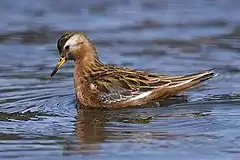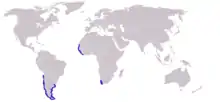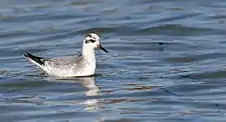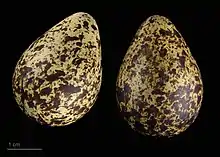Red phalarope
The red phalarope or grey phalarope (Phalaropus fulicarius) is a small wader. This phalarope breeds in the Arctic regions of North America and Eurasia. It is migratory, and, unusually for a wader, migrating mainly on oceanic routes and wintering at sea on tropical oceans.
| Red phalarope | |
|---|---|
 | |
| Scientific classification | |
| Kingdom: | Animalia |
| Phylum: | Chordata |
| Class: | Aves |
| Order: | Charadriiformes |
| Family: | Scolopacidae |
| Genus: | Phalaropus |
| Species: | P. fulicarius |
| Binomial name | |
| Phalaropus fulicarius | |
 | |
| Breeding distribution | |
 | |
| Wintering range | |
| Synonyms | |
| |
Taxonomy
The red phalarope was one of the many bird species originally described by Carl Linnaeus in his landmark 1758 10th edition of Systema Naturae, where it was given the binomial name of Tringa fulicaria.[2]
The English and genus names for phalaropes come through French phalarope and scientific Latin Phalaropus from Ancient Greek phalaris, "coot", and pous, "foot". The specific fulicarius is from Latin fulica, "coot". Coots and phalaropes both have lobed toes.[3][4]
Description

The red phalarope is about 21 cm (8.3 in) in length, with lobed toes and a straight bill, somewhat thicker than that of red-necked phalarope. The breeding female is predominantly dark brown and black above, with red underparts and white cheek patches. The bill is yellow, tipped black. The breeding male is a duller version of the female. Young birds are light grey and brown above, with buff underparts and a dark patch through the eye. In winter, the plumage is essentially grey above and white below, but the black eyepatch is always present. The bill is black in winter. Their call is a short beek.
| Standard Measurements[5][6] | |
|---|---|
| length | 200–230 mm (7.7–9 in) |
| weight | 55 g (1.9 oz) |
| wingspan | 430 mm (17 in) |
| wing | 121–132 mm (4.8–5.2 in) |
| tail | 58.5–67.1 mm (2.30–2.64 in) |
| culmen | 21–23 mm (0.83–0.91 in) |
| tarsus | 21.8–23 mm (0.86–0.91 in) |
Breeding

The typical avian sex roles are reversed in the three phalarope species. Females are larger and more brightly coloured than males. The females pursue males, compete for nesting territory, and will aggressively defend their nests and chosen mates. Once the females lay their olive-brown eggs, they begin their southward migration, leaving the males to incubate the eggs and care for the young. Three to six eggs are laid in a ground nest near water. Incubation lasts 18 or 19 days.[5] The young mainly feed themselves and are able to fly within 18 days of birth.
Behaviour
When feeding, a red phalarope will often swim in a small, rapid circle, forming a small whirlpool. This behaviour is thought to aid feeding by raising food from the bottom of shallow water. The bird will reach into the outskirts of the vortex with its bill, plucking small insects or crustaceans caught up therein. They sometimes fly up to catch insects in flight. On the open ocean, they are found in areas where converging ocean currents produce upwellings and are often found near groups of whales. Outside of the nesting season they often travel in flocks.
This species is often very tame and approachable.
Status and conservation
The red phalarope is one of the species to which the Agreement on the Conservation of African-Eurasian Migratory Waterbirds (AEWA) applies.
References
- BirdLife International (2012). "Phalaropus fulicarius". IUCN Red List of Threatened Species. 2012. Retrieved 26 November 2013.
- Linnaeus, Carl (1758). Systema Naturae per Regna Tria Naturae, Secundum Classes, Ordines, Genera, Species, cum Characteribus, Differentiis, Synonymis, Locis (in Latin). Vol. I (10th revised ed.). Holmiae: (Laurentii Salvii). p. 148 – via The Internet Archive.
- "Phalarope". Oxford English Dictionary (Online ed.). Oxford University Press. (Subscription or participating institution membership required.)
- Jobling, James A (2010). The Helm Dictionary of Scientific Bird Names. London: Christopher Helm. pp. 165, 301. ISBN 978-1-4081-2501-4.
- Godfrey, W. Earl (1966). The Birds of Canada. Ottawa: National Museum of Canada. p. 166.
- Sibley, David Allen (2000). The Sibley Guide to Birds. New York: Knopf. p. 195. ISBN 0-679-45122-6.
External links
| Wikimedia Commons has media related to Phalaropus fulicarius. |
| Wikispecies has information related to Phalaropus fulicarius. |
- Red phalarope at eNature.com
- Red phalarope stamps from Iceland, Kiribati and Sierra Leone at bird-stamps.org
- BirdLife species factsheet for Phalaropus fulicarius
- "Phalaropus fulicarius". Avibase.

- "Red phalarope media". Internet Bird Collection.
- Red phalarope photo gallery at VIREO (Drexel University)
- Interactive range map of Phalaropus fulicarius at IUCN Red List maps
- Red phalarope - Phalaropus fulicarius - USGS Patuxent Bird Identification InfoCenter
- Audio recordings of Red phalarope on Xeno-canto.
- Phalaropus fulicarius in Field Guide: Birds of the World on Flickr
- Red phalarope media from ARKive


